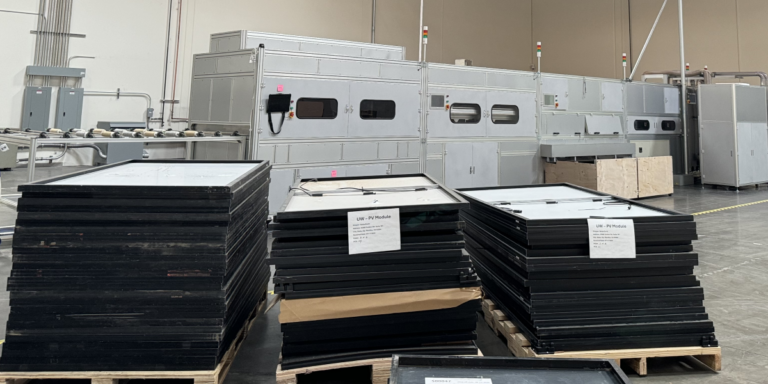PV Circonomy, based in California, has launched a recycling and treatment service for Silicon-PV panels at the end of the lifespan (EOL) based on a highly automated, own technology that is said to have a recovery rate of 99.3%. The solution includes the recovery of EVA and glass material for use in other industries.
The PV Circonomy, based in California, has launched recycling services for Silicon PV panels at the end of the lifespan (EOL) based on its own, highly automated equipment that separates, repaires and processes PV panel components.
The material repair percentage of the startup is certified by SGS in Switzerland. “Our recovery equipment has been tested by SGS with certification that stated that 99.3% recovery percentage and currently demonstrates that the energy consumption of each panel for the recovery is 1 kWh,” Andrew Hung, CEO of PV Circonomy, said ” PV -Magazine.
“PV Circonomy was founded in the United States as the business headquarters. The primary task is to support the ban of California in the field of chemical and thermal treatment instructions and to resolve the PV panel recycling problem through economic benefits. “It is indeed one of the few companies in California approved to recycle and treat PV modules by the Ministry of toxic Fabric Control of the State.
The company was founded by the founders of Taiwan-featured TSGC, a national spin-off company from the University of Tainan that was founded in 2022 to commercialize new recycling technology for EOL Silicon Solar PV panels.
The recycling line includes the most important PV circulator unit, plus two units to process recycled material, such as Ethylene Vinylacetate (EVA) and glass, to a purity level that is high enough to repeatedly reuse in other industries, along with EasycyCle, the data technology, Compliant with blockchain protocols, which one Sabotage-proof offers track and tracing documentation.
The PV circulator unit has a nominal capacity of 60 kW. It processes mechanically a 60-cell or 72-cell PV panel per minute (1 PC/minute), up to 10,000 tons per year, according to the manufacturer.
It automatically removes the aluminum frames and connection boxes from the panels. The rest of the solar panel materials are ground by low and cooled by the air flow to room temperature to prevent chemical reactions, according to the manufacturer.
The air stream process separates and collects the rear leaves, encapsulation and cell materials, preventing the material. By using airflow processing, the recycled silicon and metals retain their semiconductor and conductive properties, making electrostatic separation possible for subsequent processing.
The equipment is based on so-called vision-artificial intelligence vision (AI Vision) technology and machine learning to scan the panels, to identify the brand and the model based on the database tasks without human intervention.
“All PV circulators are built in a neural network to share optimized experience, causing double machine learning processes,” Hung said.
The solution includes a glass processing unit to recycle material that meets the ASTM C1866 stand for ground glass Pozzolan, a material that can be used to reduce the amount of cement in concrete, according to the company.
An extra EVA-recycling machine reportedly integrates a thermoharding polymer de-linking technology to refine the material in a post-consumer recycled (PCR) polymer material at a quality level that is high enough for use in shoe soles or yoga mats. The recycled polymer is of superior quality because of the use of EVA materials by the PV industry that are uniform in color and properties, according to Hung.
Looking ahead, the company provides that offering so-called hardware-as-a-service (hare) outside of California and leasing the PV circulator equipment to its partners, as well as dismantling bodies or local recyclers. The equipment is indeed designed to fit in a standard US 53-foot trailer container for convenience of transport and shipment.
Recycling equipment together with dismantling projects avoids the need to transport EOL PV panels to a distant recycling facility and may reduce their products.
This content is protected by copyright and may not be reused. If you want to work with us and reuse part of our content, please contact: editors@pv-magazine.com.


